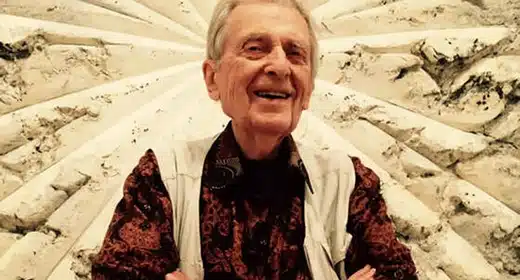June, 1970: an interesting time. Behind the scenes at the Grateful Dead Festival Express tour: an interesting place.  But if you want to see something really interesting, stroll past the roadies, the groupies, the freaks. Buttonhole the clean-cut, older guy in a suit. His name: Stanley Krippner.
But if you want to see something really interesting, stroll past the roadies, the groupies, the freaks. Buttonhole the clean-cut, older guy in a suit. His name: Stanley Krippner.
You could see Krippner at scores of Dead shows. But at this one, you could see more. “Stan and I are backstage, and I look down at his sportcoat — he’s wearing a really natty sportcoat — and there’s a whole family of ants living in his breast pocket,” recalls Bill Kreutzmann, one of the Dead’s drummers. “So I say, ‘Hey Stan, you’ve got a whole entourage of ants living in your pocket, you know that?’ And he says, ‘They come and they go. It’s a whim thing. Some people see them and some people don’t.'”
Kreutzmann chuckles, savoring the memory. “You could see anything around Stan. Anything was permitted.”
Not quite two months later, the Dead debuted a song at the Fillmore in San Francisco called “Truckin’,” which contains a line that’s crossed the minds of so many people who, suddenly, find themselves in the present: “What a long, strange trip it’s been.” They weren’t thinking of Krippner — unless, of course, it was a precognitive message somehow beamed to 1970 from the current day. Krippner would be the first to admit this is improbable — but perhaps not impossible. After all, around him, you can see anything.
For the better part of the past 40 years, Krippner, 79, has been a psychology professor at San Francisco’s Saybrook University, a small graduate school near Jackson Square established in 1971 by the founders of psychology’s humanistic movement. He has penned close to 1,000 papers on subjects as far-reaching as childhood creativity, combating soldiers’ post-traumatic stress disorder, and worldwide shamanistic rituals. He has won more laurels from more organizations than he can keep track of, including several lifetime achievement awards from the American Psychological Association — the world’s largest organization of psychologists and the definer of mainstream thought in the field.
And yet, among Krippner’s cavalcade of papers are the following eye-openers: “LSD and Parapsychological Experiences,” “The Paranormal Dream and Man’s Pliable Future,” and “An Experiment in Dream Telepathy with the Grateful Dead.” (That last one, perhaps the only scientific study undertaken at the behest of Jerry Garcia, was published in the incomparably titled Journal of the American Society of Psychosomatic Dentistry and Medicine).
Krippner has traveled to every continent, save Antarctica, to participate in mind-altering tribal ceremonies or investigate “psychic claimants,” and ventured behind the Iron Curtain to inspect “psychotronic generators” built to store and harness “psychic energy.”
He has established a firm standing in the realm of parapsychology — the scientific study of psychic phenomena generally known as extrasensory perception — akin to the Dead’s place in the pantheon of rock ‘n’ roll. Among both “advocates” and “counter-advocates” of ESP, his decade of meticulous experimentation with “dream telepathy” is viewed as some of the field’s strongest and most methodologically sound work of the 20th century.
“Stan belongs on the Mount Rushmore of parapsychology,” says fellow ESP researcher Charles Tart. James “The Amazing” Randi, perhaps the world’s most prominent skeptic, also offers Krippner his benediction: “There are so few things in this field you can depend on, and there are so many people who are prejudiced and biased. But I can depend on Stan. And I don’t think he’s biased at all.” In 1981 Randi bestowed on Tart a “Pigasus Award” for achievement in pseudoscience; they are not, to put it mildly, bosom buddies. But both consider Krippner a friend.
There are mystic healers perched on jungle mountaintops and tweed-suited aristocrats of academia perched within ivory towers. There are strident “believers” who equate a refusal to accept ESP as established truth with scientific bigotry and dubious scholars who insist the tenets of parapscyhology would undermine the laws of physics that gird our universe. And Krippner is the hub that connects them all. Like the shamans he studies, he moves effortlessly between any number of worlds. And what has his long, strange trip led him to believe? “To be very frank,” he says in his unusually high-pitched, youthful voice, “I don’t believe in much of anything.”
When it comes to the study of the paranormal, Krippner — the field’s elder statesman and author of some of its foundational studies — says “I am not a believer.” He likes to “play” with ideas. “But just because I play with ideas does not mean I accept those ideas.” Krippner has spent the better part of his career — and life — literally chasing a dream. But, after so many decades, the validity of his and others’ ESP studies are like an ant creeping through his jacket backstage at that Dead show of so long ago: Some people see it and some people don’t.
When Krippner discovered federal agents were monitoring him, he took to writing letters in triplicate to his Soviet parapsychologist colleague Vladimir Raikov. On the second copy he’d pen “For the CIA.” On the third he inked “For the KGB.” Raikov, of course, received just the one, unmarked letter. This remains a source of great mirth for both men.
In addition to reading his mail, the FBI and CIA followed Krippner closely enough to include in his dossier a description of him as a 5-foot-10 male with brown hair and blue eyes who is “anything but approachable.” Time has whitened Krippner’s hair and stiffened his gait (being run over by a truck 25 years ago in Spain contributed as well). But unapproachable?
When Krippner’s plane touches down in Brazil, they’re always there to meet him. Three to four dozen total strangers want him to interpret their dreams on the spot, offer advice, travel to their villages to inspect paranormal goings-on, or simply shake hands. “They’re waiting for him like he’s a rock star,” says Sex at Dawn author Christopher Ryan, Krippner’s former student and frequent traveling companion. “Stanley just has a total lack of ego; he’s not good at saying no. He would stay there all night. One of my jobs was to pull him away from those people. I got to be the asshole for hire.”
If the Feds really wanted to approach Krippner, they should have asked him to collaborate on a book. One pile of loose papers nearly 3 feet high towers over the other paper piles on the L-shaped desk in Krippner’s San Francisco office — “that’s stuff I’m writing,” he notes. Dozens of finished products in the corner are a testament to both his wide breadth of interests and inability to fend off would-be collaborators. Among works on shamans and dreams, however, The Park Avenue Diet seems out of place. Dr. Stuart Fischer, the book’s primary author, notes that Krippner’s concept of “personal mythology” made him a natural co-writer of a book that deigns to move past merely telling people how to eat. But there’s more: “Stan changed my dreams with ESP!” gushes Fischer.
Krippner spent 1964 to 1973 in the basement. Working in the catacomb-like corridors beneath Maimonides Hospital in Brooklyn, Krippner had the rare distinction of penning “Dream Lab Director” under “occupation” on his IRS forms. Even generations later, it’s hard to find a subsequent parapsychological study that has delivered such striking results. “In terms of just knocking your socks off,” says U.C. Irvine statistics professor and parapsychology “advocate” Jessica Utts, “What they produced is some of the most exciting stuff.” Those results were wrung out of a time-consuming and costly procedure that, at its core, involved the mind-numbing necessity of observing a subject sleep. All night. Repeatedly.
While the subject dozed away, wired to an electroencephalogram, a scientist in the next room waited for rapid eye movement (REM) sleep to commence. When it did, the scientist would hit a buzzer, and then the process began. That buzzer alerted the “agent,” who was ensconced in a remote room somewhere within the hospital. The agent would remove a randomly chosen photograph or art print from a sealed envelope and attempt to mentally “send” it to the slumbering subject. This purported transmission of information from one individual to another is known as telepathy. At the end of each REM session, the subject was awakened and made to describe his or her dreams. These transcripts were delivered to independent judges, who selected which of an array of images the description of the dreams corresponded to. Over the course of a decade, the participants in the telepathy experiments Krippner administered alongside Montague Ullman and Charles Honorton were judged to have dreamed of the agents’ images at a hit rate far exceeding the baseline odds of mere guessing. Randomly obtaining these results would require Powerball-like odds.
The knock on parapsychology studies has long been that any so-called evidence of ESP is usually limited to negligible effects only detectable after scouring massive bodies of data. “Those to whom this criticism has any appeal should be aware that the Maimonides experiments are clearly exempt from it,” wrote Irvin Child, Yale’s former psychology department chair, in American Psychologist, the APA’s flagship journal. “I believe many psychologists would, like myself, consider the ESP hypothesis to merit serious consideration and continued research if they read the Maimonides reports for themselves.”
Dream telepathy is a field that has treated Krippner well. He doesn’t have much company. Prominent skeptic Ray Hyman praises Krippner’s dream lab studies as “interesting work” and admits “there’s no smoking gun to say they didn’t have something.” But, he adds, no one has ever duplicated the striking success of the Maimonides dream lab — a charge to which Krippner pleads guilty. “There you have it,” he admits with a shrug. This, he notes, is a perfect example of skeptics’ standby critique of parapsychology — it just doesn’t repeat on demand.
And yet, it’s not so easy to dismiss Krippner’s overall assertion that something — something — was happening in those experiments to indicate we don’t yet understand every last mystery of the universe. As a teenage lab assistant and subject, Fischer dreamed of men struggling to walk against a snowstorm. As the agent that night, Krippner concentrated on a Japanese portrait of just that. Many decades later, Fischer accompanied Krippner to a symposium in Kyoto. As they left for their hotel, a snowstorm whipped up, and the men struggled to walk against it.
Professor Donadrian Rice is now the chair of the University of West Georgia’s psychology department. In 1969, however, he was an undergraduate researcher in Krippner’s lab and a small-town South Carolina kid in the big city. At one point he told the dream lab director that he’d never tried mescalin. That’s an odd thing to say to your boss, but Krippner’s response was more unconventional still. He scored Rice a hit and escorted his tripping assistant to a showing of Fantasia. This is a fond memory for Krippner; the movie is one of his favorites, and he recalls he made sure to take Rice to a 3-D showing so “all the characters would be jumping off the screen.” Rice, who had never seen Fantasia — let alone while on mescalin — recalls it as “a pretty intense movie to see under those conditions.”
The mescalin and other hallucinogens were floating around the lab, in Rice’s recollection, for “side research” and “off the record” studies on telepathy. Krippner remembers things differently than his longtime friend — experiments involving illegal drugs, he says, would have put him in a bad place with the hospital board. Hallucinogens around the lab were “only being used during recreational periods.” There was, however, that one experiment where, per the words of Bob Dylan, everybody must get stoned. That was the one written up in the Journal of the American Society of Psychosomatic Dentistry and Medicine. But that wasn’t in the lab.
The music died down on a February night at the Capitol Theater in Port Chester, N.Y., and 2,000 heads gazed up at the stage, nearly all of them “in various altered states of consciousness induced by marijuana, hashish, LSD, and the music itself,” per Krippner. On a screen suspended above the Grateful Dead, the following words appeared: “YOU ARE ABOUT TO PARTICIPATE IN AN ESP EXPERIMENT.” The concertgoers were informed they would soon be shown a picture, which they should “TRY USING YOUR ESP TO ‘SEND'” to Malcolm Bessent, a self-proclaimed psychic dozing in the dream lab, 45 miles off.
Asking a member of the Grateful Dead if he remembers any particular concert is akin to asking Willie Mays if he recalls a random midseason ballgame. But band members haven’t forgotten “the ESP shows.”
“Oh, I remember,” confirms Mickey Hart, one of the band’s drummers. The Dead, in Hart’s recollection, stopped playing while the crowd read the instructions. But as soon as the images were projected onscreen “we began playing really hard to be totally engaged in that experiment. We were the vehicle, the thing at the center of it all.”
On four of the six concert nights, a pair of independent judges deemed Bessent’s dreams to be highly relevant to the image sent his way by the Deadheads. On Feb. 19, 1971, for example, concertgoers were shown a painting titled The Seven Spinal Chakras, picturing an ethereal man hovering in the lotus position with symbols projected onto his spinal cord. That night, Bessent reported dreaming about a man who was “suspended in mid-air or something…. I was thinking about … a spinal column.”
In their subsequent writeup, Krippner and his colleagues remarked on the need for “future work” to explore the “intriguing” notions that being high on LSD, miles away from your telepathic subject, and having thousands of senders might have an effect on the yet-unproven power of telepathy. That didn’t exactly happen. Krippner, however, did later that year debrief an auditorium full of Soviet scientists about his work with the Dead (“a band with a keen interest in both ESP and altered states of consciousness”) and gifted his hosts with several of the group’s LPs.
For decades, this study was known only to those Soviets and the most staunch aficionados of psychosomatic dentistry. Then it was exhumed by the Dead.
The burgeoning ranks of academics analyzing the Grateful Dead unearthed Krippner’s works in the late 1980s, declaring them to be the first scholarly papers on the band. In the ensuing decades, members of the Grateful Dead Scholars Caucus have published hundreds of papers and dozens of books. The group has held a national gathering for 15 consecutive years; Krippner is a frequent guest and is hailed as the field’s godfather. “The proper way to contextualize Stanley’s work is that it was a way of measuring the bond between the fans and the band,” says Nicholas Meriwether, director of U.C. Santa Cruz’s Grateful Dead Archive and founder of the Scholars’ Caucus. “Even though he wasn’t making this claim, that’s the great claim found there.” Hart agrees, noting “the powerful buzz” and “great union” pervading the ESP shows.
Hart credits Krippner with an even more seminal role in the lore of the Dead. On a number of occasions, Krippner hypnotized Hart and Kreutzmann to better synch their drumming. “We’d find the inner workings of rhythm, a special lock between me and Bill. We found what we would call ‘The Root Lock,'” Hart recalls. In hypnosis, the drummers could play for eight, 10, or 12 hours straight without a break. “Bill and I were able to go deep. Sometimes he’d play with his right arm around me and I had my left arm around him; we were one organism.” It was only with two drummers in deep unison, Hart continues, that the band could produce the Dead’s signature sound. And it was only with Krippner’s direction that Hart and Kreutzmann managed to start their own long, strange trips. “We never got into that before we met Stanley,” Hart says. “He was the catalyst.”
After Meriwether kindly volunteers to send SF Weekly the latest edition of Dead Studies, the quarterly of the Grateful Dead Archive, he is momentarily flummoxed by the newspaper’s address. The newsroom’s suite number, 710, is identical to the address of the Dead’s famed Ashbury Street abode of the 1960s. “Dude, that’s a great number,” he says. “Serendipity and synchronicity abound. You just proved that.” If only it were so easy.
Had Isaac Newton set out to formulate the laws of parapsychology instead of gravity, he’d have been in for a challenge. Because in the world of parapsychology, the apple does not observably fall from the tree every time — or even consistently. Perhaps only people sympathetic to the notion of falling apples will see the apple fall, and only then in ideal apple-falling conditions. Parapsychology, laments skeptic Ray Hyman, is “the only field of scientific inquiry” that lacks even one established experiment to “be assigned to students with the expectation that they will observe the original results.” There is, he continues, no demonstration of telepathy, clairvoyance (mind-reading), or psychokinesis (the ability to mentally move or influence objects) for which parapsychologists “can confidently specify conditions that will enable anyone — let alone a novice — to reliably witness the phenomenon.”
Psychic ability, counter its advocates, cannot be reproduced on cue. Statistician Jessica Utts, also a Parapsychological Association board member, compares the situation to baseball: “Even the best hitters … cannot hit on demand. Nor can we predict when someone will hit or when they will [hit] a home run,” she writes. “We cannot even predict whether or not a home run will occur in a particular game. That does not mean that home runs don’t exist.”
Krippner likens it to America’s other national pastime: “Whatever psychic ability is, it’s not something you can turn on and off. It’s a bit like sexual experience — you can’t guarantee every experience will be ecstatic or blissful. The conditions have to be just right for it. Sex doesn’t operate on demand. It’s just too complicated.”
You can see home runs and you can see sex — and, for that matter, you can see apples falling out of trees. But, in a laboratory setting, you don’t exactly “see” ESP. The field’s most compelling work is the result of painstaking repetitions, complex tabulations, and “statistically significant” deviations from the “null hypothesis” — the outcome you’d expect due to sheer chance. To dismiss the results of successful studies as mere statistical flukes — be they Krippner’s work at Maimonides or the decades-long, government-funded psychic experiments at Stanford — would veer into fanaticism. Yet beating the null hypothesis is one thing. It’s another to explain how you did it — and then do it again.
In his overwhelmingly positive analysis of the Maimonides dream telepathy experiments, Yale’s Irvin Child affirmed that Krippner’s results were intriguing and the methodology was sound — but nothing was proven. “Statistical significance indicates only the presence of consistency,” wrote Child, “and does not identify its source.” Even repetitions of “the statistically significant outcome of the Maimonides experiments” wouldn’t “establish the presence of the kind of anomaly called ESP.” Repetitions, of course, have been hard to come by.
And this encapsulates the ongoing cycle of parapsychology. Over the years, one study after another has been released alleging that something is going on; last year Cornell psychology professor Daryl Bem made waves claiming experimental evidence of “precognition” when subjects guessed the location of erotic imagery behind multiple curtains at better-than-chance odds. Eventually, numerous studies are bundled together via a process called meta-analysis, which advocates claim indicates that something is really going on. But, sex and baseball analogies notwithstanding, nothing is happening on demand. So it’s a debatable point that “the presence of the kind of anomaly called ESP” is any more established now than it was when the Dead were dropping by to visit Krippner at the dream lab. In the ongoing debate between parapsychology’s advocates and counter-advocates, an agreement hasn’t even been reached on the shape of the table. This ought to put Krippner — a unique conduit between the two camps and skeptics’ favorite parapsychologist — in an awkward place. But it doesn’t.
Rather than crossing swords with the critics of parapscyhology, Krippner often finds himself nodding his head — “really, I agree with about 95 percent of what they say. Nothing in parapsychology is guaranteed to replicate. So, really, I understand where the counter-advocates are coming from.” He does not expect to see mainstream scientific acceptance of ESP in his lifetime. Sadly, he does not even expect to see the day ESP research acquires mainstream approval as a worthwhile endeavor. “And I am not losing sleep over this.” Despite spending the bulk of his life in the field, it’s just not something he gets worked up over. “I don’t have any great emotional investment in this. The world is not gonna stand or fall based on one experiment or another. I have done what I can to expand the boundaries of science and human capacities. If [the argument for parapsychology] falls apart — so be it. If it is established, we’ve done what scientists are supposed to do.”








































